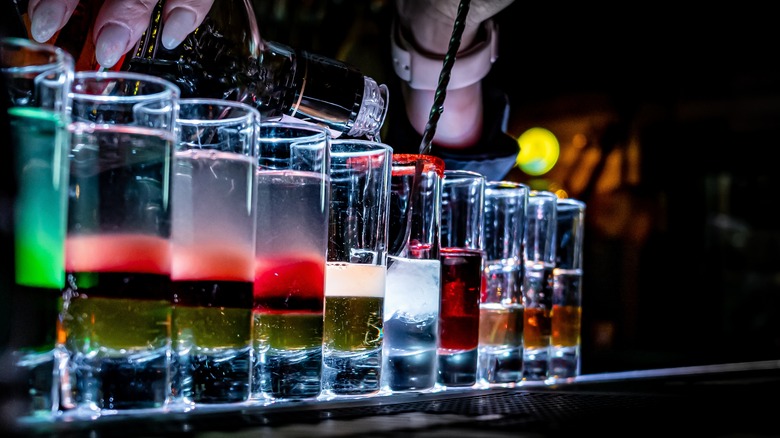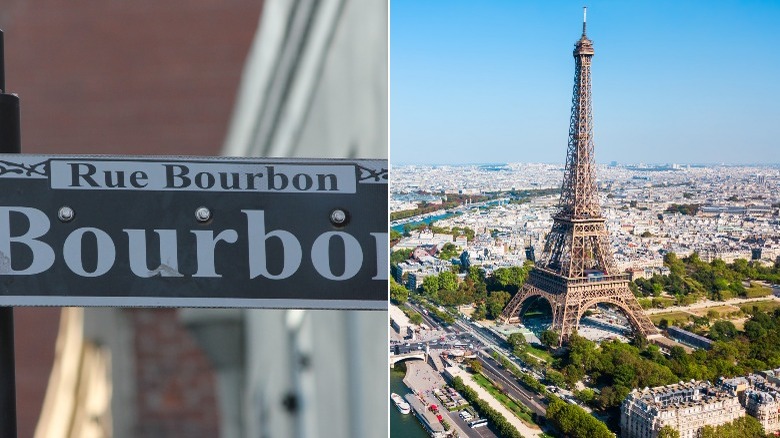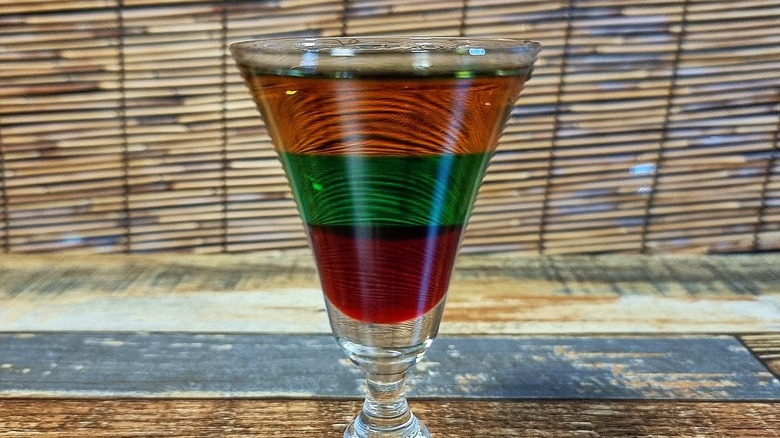Pousse Cafe: The French Cocktail Variety You Should Know About
Some classic cocktails continue to stand the test of time. Among the top 10 in Nio Cocktails list are the Cosmopolitan, Gimlet, Manhattan, and Old Fashioned. Then there are those classics of yesteryear that took an extended leave of absence and are starting to make a comeback. According to Barron's list, drinks like the Salary Man, Imperial Americano, and Clover Club are all making their return to the bar scene. However, one classic cocktail remains just on the edge of resurgence. That is the decidedly — or not so decidedly, as we'll see — French creation known as the pousse cafe.
Pousse cafe — French for "coffee pusher" — is a multilayered cocktail in which each successive layer is clearly defined. As Serious Eats tells us, the layers result from physics, each having a different density. The most dense liquid serves as the base, with each successive layer becoming lighter. This is simultaneously the pousse cafe's great strength and weakness. It is easy to go overboard with the layers and end up with a mess. Still, it is a cocktail worth knowing. We'll take you on a trip through its history, when it's appropriate to drink one, and the types of cocktails that fit in this class.
The origins of the pousse cafe
There are two schools of thought regarding the origins of the pousse cafe. The first and most widely accepted is that the cocktail was created in 19th century France. As Punch explains, the original pousse cafe, while not a layered drink, was a mixture of liqueurs typically served after dinner during the coffee course. More on that later.
The second school of thought, explained in a video by BarTalk & Cocktails, is that the pousse cafe was invented in New Orleans. Stanley Clisby Arthur, author of "Famous New Orleans Drinks and How to Make 'Em," lists numerous recipes for pousse cafe, one of which is Santini's Old New Orlean's Pousse Cafe. This creation of Italian bartender Joseph Santini is said to be the first pousse cafe to combine rum and brandy and was very popular in 1850's New Orleans.
The first printed recipe for a pousse cafe came in 1862 with the publication of "How to Mix Drinks" by Jerry Thomas. Thomas set the standard for bartending and drink mixing that still lives on today (see KRCW). In the book, Thomas lists five recipes for pousse cafe, one of which is the famous Pousse l'Amour. Regardless of its origin, the sources make it clear that by the late 19th century, pousse cafe was a fun and popular drink variety in both America and France.
A variety of pousse cafes
There isn't exactly a definitive recipe for a pousse cafe. By its very nature, it is more of a creation on the whim of whoever is tending the bar. That being said, there are certain liqueurs that, over time, have become associated with pousse cafes. Serious Eats lists crème de cassis, Chartreuse, Grand Marnier, port, and cognac as basic building blocks for a pousse cafe. However, these can easily be swapped in favor of other liqueurs such as multi-colored curacao, Cognac, raspberry syrup, grenadine, creme de menthe, and anisette.
A variety of pousse-like cocktails have emerged throughout history. The Pousse l'Amour from Jerry Thomas' "How to Mix Drinks" (cited here in Punch) is a layering of maraschino liqueur, vanilla cordial, a raw egg yolk, and a dash of brandy. Other cocktails, such as the "Angel Drinks” popular during prohibition, are pousse cafes with a diary base and a type of creme liqueur.
When and how to drink a pousse cafe
A pousse cafe was originally used as a digestif, which Thrillist explains is a type of liqueur intended to aid digestion. The combination of herbs and other plants used in digestifs often lent the liqueur a medicinal quality. Digestifs, or digestivos as the Italians call them, were had after dinner, either during or after the coffee course. With pousse cafe literally translating to "coffee pushing," the concept behind drinking one was to help aid in erasing the aftertaste of dinner from your palate, according to BarTalk and Cocktails. Basically, it's a fancy chaser.
The video also clarifies exactly how one is meant to drink a pousse cafe. Much like limoncello is for the Italians, a pousse cafe is meant to be sipped, not downed like a shot. As each successive layer is sipped away, the bitterness and strength of the top alcohols give way to the sweeter, thicker liqueurs on the bottom. Based on the alcohol by volume content, the mixers with the higher booze volume tend to have less weight than those with lower volumes. And while the pousse cafe is far more a work of art than an actual proper drink, it is nonetheless an interesting phenomenon in the cocktail world. And for that reason, it deserves some attention.



